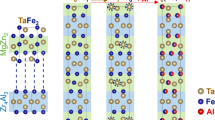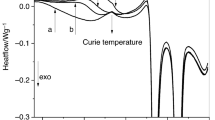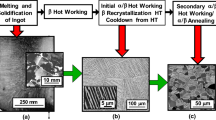A new approach to explaining structure formation processes in alloys during heat treatment is suggested, which differs essentially from the traditional one. Experimental proof of the hypothesis that processes occurring in alloys during heat treatment develop due to interatomic chemical bonds (ionic and covalent) existing at condensed state temperatures is provided. This means that at each heating temperature alloy acquires a microstructure differing from that formed at other temperatures with respect to composition or size of precipitating particles. This makes quenching from the range of disordered solid solutions a superfluous operation, especially in the light of the fact that such solutions do not exist in nature. It is recommended to exclude quenching from the production process, which should limited solely to tempering.


Similar content being viewed by others
References
J. Higgins, R. B. Nicholson, and P. Wilkes, “Precipitation in iron-beryllium system,” Acta Metall., 22, 201 – 217 (1974).
D. E. Laughlin and J. W. Cahn, “Spinodal decomposition in age-hardening Cu – Ti alloys,” Acta Metall., 23, 329 – 339 (1975).
Y. Ustinovshikov, M. Shirobokova, and B. Pushkarev, “A structural study of the Fe – Cr system alloys,” Acta Mater., 44(12), 5021 – 5032 (1996).
Y. Ustinovshikov, The “Ordering – Phase Separation” Transition in Alloys, Cambridge Scholar Publishing, Great Britain (2019).
Y. Ustinovshikov, “Nucleation of new phases in alloy: a long way to true,” Adv. Mater. Phys. Chem., 12(10), 1 – 20 (2022).
Y. Ustinovshikov, “Formation of diffusion micro-pairs in the Ni68Mo20Al12 alloy,” Mater. Lett., 326, 132936 (2022).
Y. Ustinovshikov and I. Shabanova, “Phase transitions in alloys of the Ni – Mo system,” Mater. Chem. Phys., 129, 975 – 980 (2011).
Y. Ustinovshikov, “Structural-thermodynamic method of phase analysis of multicomponent alloys based on the example of the Ni50Co25Mo25 alloy,” J. Alloys Compd., 614, 113 – 117 (2014).
Y. Ustinovshikov, I. Shabanova, and N. Lomova, “TEM study of the “ordering – phase separation” transition in Ni – Co alloys,” J. Adv. Microsc. Res., 8, 276 – 282 (2013).
Author information
Authors and Affiliations
Corresponding author
Additional information
Translated from Metallovedenie i Termicheskaya Obrabotka Metallov, No. 6, pp. 3 – 7, June, 2023.
Rights and permissions
Springer Nature or its licensor (e.g. a society or other partner) holds exclusive rights to this article under a publishing agreement with the author(s) or other rightsholder(s); author self-archiving of the accepted manuscript version of this article is solely governed by the terms of such publishing agreement and applicable law.
About this article
Cite this article
Ustinovshchikov, Y.I. Role of Metallic Alloy Interatomic Chemical Reactions with Structure Formation during Heat Treatment. Met Sci Heat Treat 65, 325–329 (2023). https://doi.org/10.1007/s11041-023-00934-x
Received:
Published:
Issue Date:
DOI: https://doi.org/10.1007/s11041-023-00934-x




